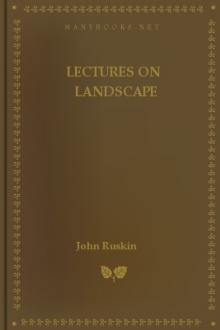The Crown of Wild Olive by John Ruskin (a court of thorns and roses ebook free .TXT) 📕

- Author: John Ruskin
- Performer: -
Book online «The Crown of Wild Olive by John Ruskin (a court of thorns and roses ebook free .TXT) 📕». Author John Ruskin
169. Carried, however, to such a degree of subtlety as this, and with so ambitious and extravagant aim, bas-relief becomes a tour-de-force; and, you know, I have just told you all tours-de-force are wrong. The true law of bas-relief is to begin with a depth of incision proportioned justly to the distance of the observer and the character of the subject, and out of that rationally determined depth, neither increased for ostentation of effect, nor diminished for ostentation of skill, to do the utmost that will be easily visible to an observer, supposing him to give an average human amount of attention, but not to peer into, or critically scrutinize the work.
170. I cannot arrest you to-day by the statement of any of the laws of sight and distance which determine the proper depth of bas-relief. Suppose that depth fixed; then observe what a pretty problem, or, rather, continually varying cluster of problems, will be offered to us. You might, at first, imagine that, given what we may call our scale of solidity, or scale of depth, the diminution from nature would be in regular proportion, as for instance, if the real depth of your subject be, suppose a foot, and the depth of your bas-relief an inch, then the parts of the real subject which were six inches round the side of it would be carved, you might imagine, at the depth of half-an-inch, and so the whole thing mechanically reduced to scale. But not a bit of it. Here is a Greek bas-relief of a chariot with two horses (upper figure, Plate XXI). Your whole subject has therefore the depth of two horses side by side, say six or eight feet. Your bas-relief has, on the scale,[131] say the depth of the third of an inch. Now, if you gave only the sixth of an inch for the depth of the off horse, and, dividing him again, only the twelfth of an inch for that of each foreleg, you would make him look a mile away from the other, and his own forelegs a mile apart. Actually, the Greek has made the near leg of the off horse project much beyond the off leg of the near horse; and has put nearly the whole depth and power of his relief into the breast of the off horse, while for the whole distance from the head of the nearest to the neck of the other, he has allowed himself only a shallow line; knowing that, if he deepened that, he would give the nearest horse the look of having a thick nose; whereas, by keeping that line down, he has not only made the head itself more delicate, but detached it from the other by giving no cast shadow, and left the shadow below to serve for thickness of breast, cutting it as sharp down as he possibly can, to make it bolder.
171. Here is a fine piece of business we have got into!—even supposing that all this selection and adaptation were to be contrived under constant laws, and related only to the expression of given forms. But the Greek sculptor, all this while, is not only debating and deciding how to show what he wants, but, much more, debating and deciding what, as he can't show everything, he will choose to show at all. Thus, being himself interested, and supposing that you will be, in the manner of the driving, he takes great pains to carve the reins, to show you where they are knotted, and how they are fastened round the driver's waist (you recollect how Hippolytus was lost by doing that), but he does not care the least bit about the chariot, and having rather more geometry than he likes in the cross and circle of one wheel of it, entirely omits the other!
172. I think you must see by this time that the sculptor's is not quite a trade which you can teach like brickmaking; nor its produce an article of which you can supply any quantity "demanded" for the next railroad waiting-room. It may perhaps, indeed, seem to you that, in the difficulties thus presented by it, bas-relief involves more direct exertion of intellect than finished solid sculpture. It is not so, however. The questions involved by bas-relief are of a more curious and amusing kind, requiring great variety of expedients; though none except such as a true workmanly instinct delights in inventing and invents easily; but design in solid sculpture involves considerations of weight in mass, of balance, of perspective and opposition, in projecting forms, and of restraint for those which must not project, such as none but the greatest masters have ever completely solved; and they, not always; the difficulty of arranging the composition so as to be agreeable from points of view on all sides of it, being, itself, arduous enough.
173. Thus far, I have been speaking only of the laws of structure relating to the projection of the mass which becomes itself the sculpture. Another most interesting group of constructive laws governs its relation to the line that contains or defines it.
In your Standard Series I have placed a photograph of the south transept of Rouen Cathedral. Strictly speaking, all standards of Gothic are of the thirteenth century; but, in the fourteenth, certain qualities of richness are obtained by the diminution of restraint; out of which we must choose what is best in their kinds. The pedestals of the statues which once occupied the lateral recesses are, as you see, covered with groups of figures, enclosed each in a quatrefoil panel; the spaces between this panel and the enclosing square being filled with sculptures of animals.
You cannot anywhere find a more lovely piece of fancy, or more illustrative of the quantity of result that may be obtained with low and simple chiselling. The figures are all perfectly simple in drapery, the story told by lines of action only in the main group, no accessories being admitted. There is no undercutting anywhere, nor exhibition of technical skill, but the fondest and tenderest appliance of it; and one of the principal charms of the whole is the adaptation of every subject to its quaint limit. The tale must be told within the four petals of the quatrefoil, and the wildest and playfullest beasts must never come out of their narrow corners. The attention with which spaces of this kind are filled by the Gothic designers is not merely a beautiful compliance with architectural requirements, but a definite assertion of their delight in the restraint of law; for, in illuminating books, although, if they chose it, they might have designed floral ornaments, as we now usually do, rambling loosely over the leaves, and although, in later works, such license is often taken by them, in all books of the fine time the wandering tendrils are enclosed by limits approximately rectilinear, and in gracefullest branching often detach themselves from the right line only by curvature of extreme severity.
174 Since the darkness and extent of shadow by which the sculpture is relieved necessarily vary with the depth of the recess, there arise a series of problems, in deciding which the wholesome desire for emphasis by means of shadow is too often exaggerated by the ambition of the sculptor to show his skill in undercutting. The extreme of vulgarity is usually reached when the entire bas-relief is cut hollow underneath, as in much Indian and Chinese work, so as to relieve its forms against an absolute darkness; but no formal law can ever be given; for exactly the same thing may be beautifully done for a wise purpose, by one person, which is basely done, and to no purpose, or to a bad one, by another. Thus, the desire for emphasis itself may be the craving of a deadened imagination, or the passion of a vigorous one; and relief against shadow may be sought by one man only for sensation, and by another for intelligibility. John of Pisa undercuts fiercely, in order to bring out the vigour of life which no level contour could render; the Lombardi of Venice undercut delicately, in order to obtain beautiful lines, and edges of faultless precision; but the base Indian craftsmen undercut only that people may wonder how the chiselling was done through the holes, or that they may see every monster white against black.
175. Yet, here again we are met by another necessity for discrimination. There may be a true delight in the inlaying of white on dark, as there is a true delight in vigorous rounding. Nevertheless, the general law is always, that, the lighter the incisions, and the broader the surface, the grander, cæteris paribus, will be the work. Of the structural terms of that work you now know enough to understand that the schools of good sculpture, considered in relation to projection, divide themselves into four entirely distinct groups:—
1st. Flat Relief, in which the surface is, in many places, absolutely flat; and the expression depends greatly on the lines of its outer contour, and on fine incisions within them.
2nd. Round Relief, in which, as in the best coins, the sculptured mass projects so as to be capable of complete modulation into form, but is not anywhere undercut. The formation of a coin by the blow of a die necessitates, of course, the severest obedience to this law.
3rd. Edged Relief. Undercutting admitted, so as to throw out the forms against a background of shadow.
4th. Full Relief. The statue completely solid in form, and unreduced in retreating depth of it, yet connected locally with some definite part of the building, so as to be still dependent on the shadow of its background and direction of protective line.
176. Let me recommend you at once to take what pains may be needful to enable you to distinguish these four kinds of sculpture, for the distinctions between them are not founded on mere differences in gradation of depth. They are truly four species, or orders, of sculpture, separated from each other by determined characters. I have used, you may have noted, hitherto in my Lectures, the word "bas-relief" almost indiscriminately for all, because the degree of lowness or highness of relief is not the question, but the method of relief. Observe again, therefore—
A. If a portion of the surface is absolutely flat, you have the first order—Flat Relief.
B. If every portion of the surface is rounded, but none undercut, you have Round Relief—essentially that of seals and coins.
C. If any part of the edges be undercut, but the general projection of solid form reduced, you have what I think you may conveniently call Foliate Relief,—the parts of the design overlapping each other in places, like edges of leaves.
D. If the undercutting is bold and deep, and the projection of solid form unreduced, you have full relief.
Learn these four names at once by heart:—





Comments (0)